Sam Topalidis (Pontic Historian and Ethnologist) 2019
- Background
This paper on traditional clothes worn by Pontic Greeks (Greeks from Pontos—the northeast corner of Anatolia adjacent the Black Sea) relies very heavily on the research by Amarantidis (2016; 2017). In these ‘diaries’ (without page numbers), Ioannis Amarantidis used literary sources, old photographs, oral histories and a careful study of original Pontic Greek costumes in his research. All praise to him for his work. Additional information used in this paper has been specifically referenced. My comments in the main text are enclosed in square brackets […]. Emphasis is placed here on the description of traditional Pontic Greek costumes worn in Pontos, not on clothes Pontic Greeks wore when they moved to the Caucasus, Russia or to Greece.
Sadly, there is a shortage of information written in English on traditional costumes worn by Pontic Greeks—and thus this current document is incomplete. But I hope it is a good start. In addition to the written word, there are some photographs of costumes worn by Greeks taken in Pontos pre-1923. Care is needed in assuming from these photographs that they represent traditional costumes as many were staged in a studio where studio ‘accessories’ may have been added to the costumes. It is also important to note that there was a similarity in the traditional costumes worn with other Pontic people, e.g. Armenian, Laz or Ottoman Turk—but these similarities are not discussed here.
Amarantidis (2016) states that the female costumes of Pontos trace their origins to the Byzantine [Eastern Roman] empire. [This is ‘stretching the truth’.]
We will probably never know exactly what most Byzantines wore most of the time. But sufficient references in texts of the middle and late periods indicate that clothing was treated as a marker of ethnicity (Kaldellis 2019, p. 52). [We have a better idea of clothes worn at the Byzantine Court.]
Until 1923 each Pontic valley was distinguished by a slightly different striped tartan. Town and market clothes were black. They probably were in the Middle Ages, too. The local black, gold, and purple or red striped cloths in Pontos, first illustrated in 19th century engravings and photographs probably have a much older origin. Each major settlement or valley favours a slightly different stripe, although whether this is because of local whim and availability, or represents an older notion of tartan, is hard to know (Bryer and Winfield 1985, p. 6).
In the Ottoman empire, the Ottoman authorities assumed clothing was to show that Muslims were first-class subjects and the non-Muslims inferiors. Dark colours, especially black, were regarded as suitable for non-Muslims. It took until after 1839 before new rules abolished these limitations (as part of the Tanzimat reforms) (Faroqhi 2016). (Note 1.)
More modern clothing for Pontic Greeks was introduced from about 1860. (Most Greek families in the large urban centres of Pontos with their international ports [e.g. Samsun and Trabzon], lived a bourgeois way of life (Broufas 2000).) (Note 2.) From the end of the 19th century most men in urban centres had adopted European dress
[like wearing suits]
. However, urban women adopted European dress later and to a lesser degree while up to 1922–23, traditional Pontic Greek female dress had not lost its important symbolic role for social events. In contrast to the urban centres, the rural Pontic Greek population preserved their local traditional attire up to the exodus [of Christians from Ottoman territory as part of the compulsory Population Exchange] in 1922–23 (Oikonomidis (1929) in Amarantidis (2016)).
After the resettlement of the Greek refugees from Pontos in 1922–23 to Greece, their traditional attire was quickly abandoned. Only in farming communities did traditional everyday wear persist and even that not long after 1930.
- Traditional Pontic Greek Female Costumes
2.1 Introduction
Older women and rural women who dressed conservatively, continued wearing the zipouna dress (Plate 1) until their exodus from Anatolia (1922–23). As stated previously, women in coastal urban centres started to absorb modernity in the latter part of the 19th century. This was a result of both commercial development (which allowed the import of ready-made clothes and fashion journals) and from 1900, the generalised use of the sewing machine which made making clothes much easier (Note 3). The traditional female costume soon took a symbolic character: even the most ‘stylish’ women had to wear a zipouna on important occasions like weddings or even if they were being photographed formally (Andrianopoulou 2005).
The traditional female dress of Pontic Greeks was relatively consistent across Pontos and north-south from the coastal urban centres to the agricultural mountainous inland. This form of dress varied for everyday, festive or bridal use. The dress was also influenced by the age of the woman who wore it and her social means. [The climate also influenced the clothing with villagers in the mountainous inland areas wearing warmer clothing.]
The following describes the female dress of Pontic Greeks as it developed in the late 19th and early 20th centuries. During this period there was a variety of attire from western European styles to the more traditional garb. The traditional female attire of Pontos is referred to as ta zipounas owing to the name of the main garment, the zipouna dress (Plate 1).
2.2 Underwear
- Vrakin: These underpants extended from the waist to just above the knee and were made of fine calico or white linen.
- Kamish: For everyday use, they were made of white cotton or linen and were open in front from the neck to the mid-section, but could go down to just above the knees. For festive or bridal wear, they were made of a linen-silk mix or all silk and made in Trabzon or Bursa.
- The breasts could be supported by a white cotton band which wrapped around them and was tied at the back over the kamish. Rarely was the cotton band wrapped next to the skin (Andrianopoulou 2005).
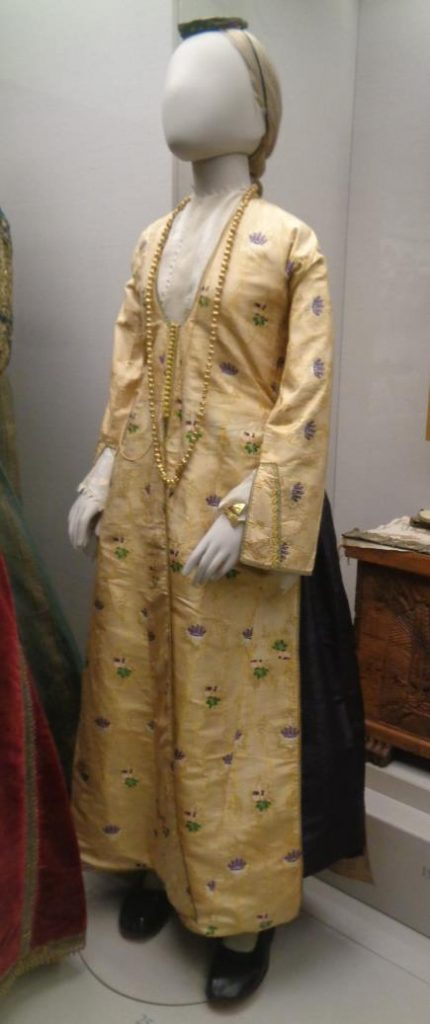
2.3 Outer garments
a. Shalvar: These were baggy pantaloons which generally fell to the ankles and were worn over the vrakin. It had the same width from the waist to the ankles. It was lined and had pleats which were visible on the side openings of the zipouna dress. Everyday shalvars were knitted from cotton or local woollen fabric. Festive shalvars were made from satin, cotton taffeta or from gold threaded fabric. [The shalvar was tied around the waist and the bottom end was tied just below the knee and allowed to fall from there towards the ankle.] (Plate 2.)
b. Sparel (spaler): The sparel covered the chest from the neck to the waist and was usually worn under the zipouna dress and covered the opening of the dress at the chest. It was tied around the neck and around the mid-section (Plate 3). It was commonly worn in agricultural areas and among elderly women in urban centres. [The sparel was not worn in all areas of Pontos.] For everyday wear it was made of cheap cotton. Festive sparel were made of expensive fabrics such as velvet, silk and satin.
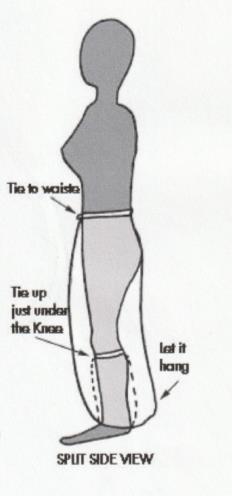

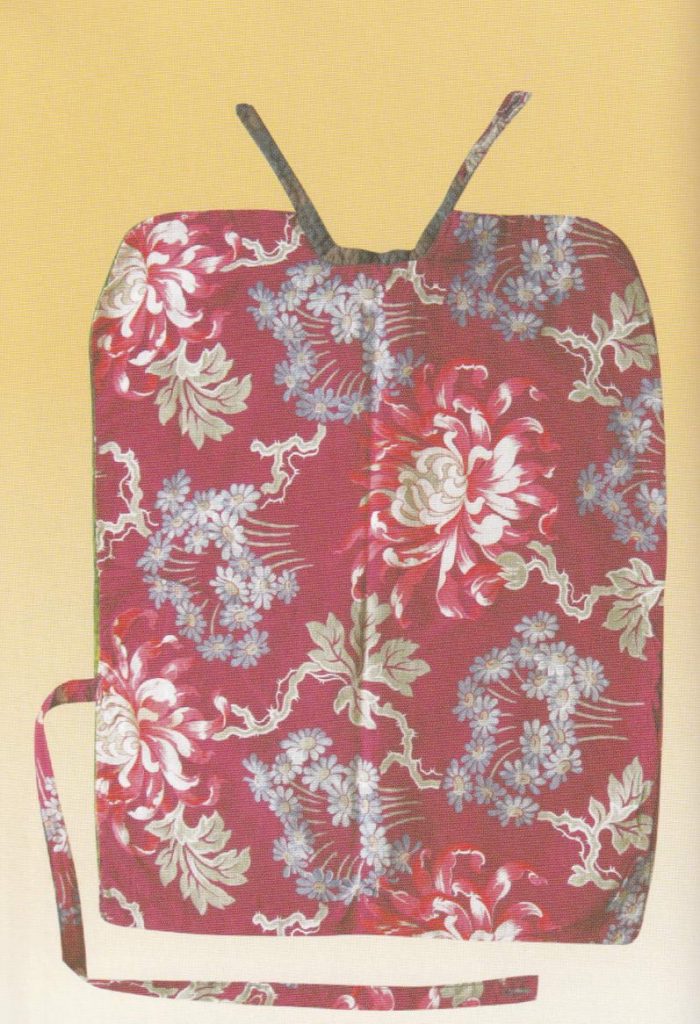
- Zipouna: The zipouna was the Pontic Greek female dress. It often reached down to the ankles (Plate 1). It was a three-panel garment with sleeves slit at the ends. The dress was open in the front from top to bottom and was buttoned from the middle of the chest to the belly button. It also had two side openings at the bottom of the dress. [The Matzouka dress had side-slits that were not very long. In contrast, side-slits on the zipouna from Trabzon went from the bottom to the waist.] An everyday dress was made from cheap cotton or wool. The winter zipouna for elderly women had a layer of cotton in the lining. Luxury fabrics such as silk, velvet, satin and taffeta were preferred for festive dresses. The bridal zipouna was usually made of silk.
- Zonar (waistband): Everyday zonars were made of local woollen fabric or cotton from Crimea. These waistbands were [up to] 3 m long and 30 cm wide. Festive waistbands were usually square or rectangular in shape which, when worn, were folded into a triangle. The types of zonars included:
- Edjemshalin: This square shape zonar was made from a multi-coloured Persian woollen shawl.
- Lahor: The lahor zonar was a piece of expensive hand-woven fine woollen material imported from Lahore, Pakistan. The lahor was square in shape with multi coloured patterns (Plate 4, costumes in the centre and on the right).
- Tarapouloz: This zonar was square in shape and was made of fine imported silk from Tripoli, Libya. It was lighter than the lahor zonar. It was multi-coloured with thick vertical and horizontal patterns, which formed small squares. At the two opposite edges there were fringes which ended in multi-coloured silk tassels which formed tufts (Plates 4, costume on the left & 5).
- Bridal zonar: This was also square in shape, made of white or off-white silk fabric which also terminated in its opposite edges in long fringes.
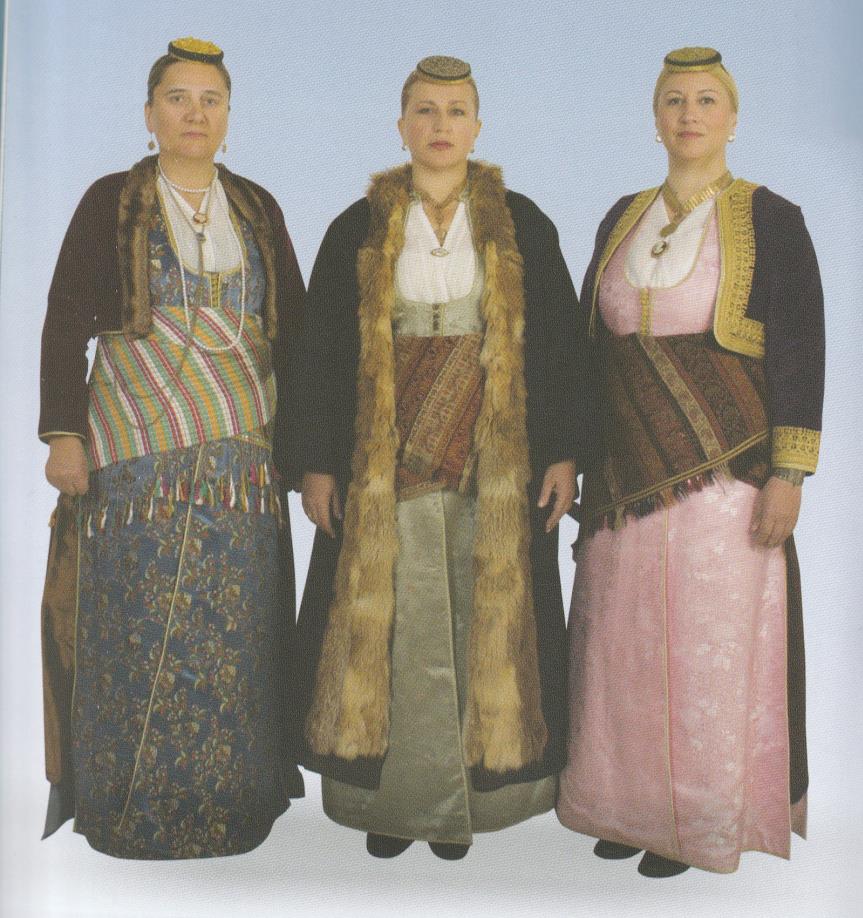
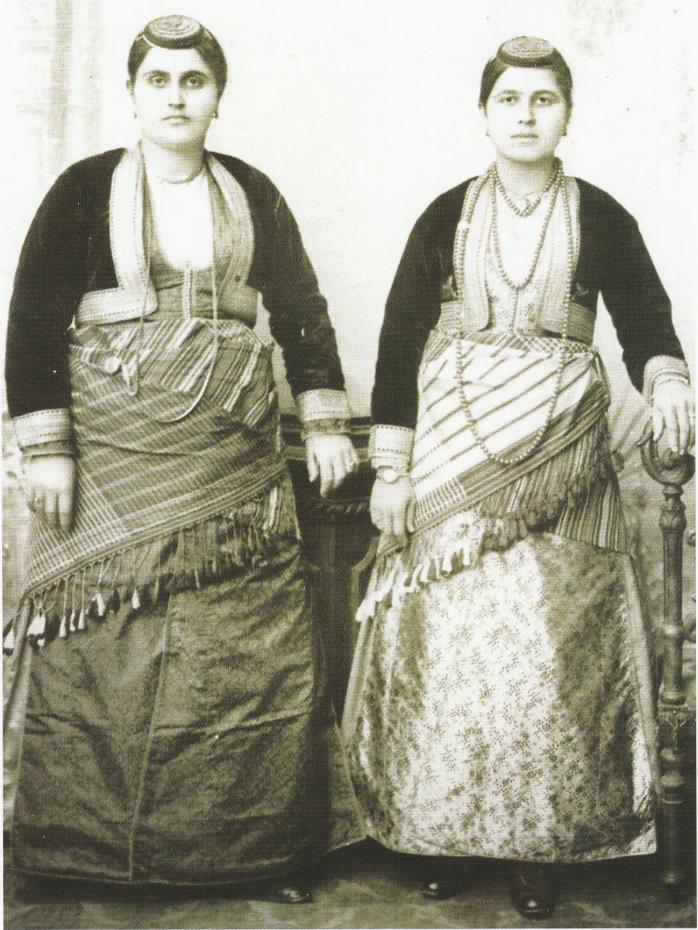
- Aprons: Pontic Greek dress worn by young women and newlyweds in urban centres did not include any special type of apron. But it was necessary attire for young wives after the birth of a child, as well as of middle aged and elderly women, as well as all women in the countryside
[to protect their dress]
. The types of aprons included:
- Fota: This was a rectangular apron with wide stripes of two alternating colours. It was made of cotton for everyday wear and silk for festive occasions. It was worn over the zipouna dress and the zonar allowing the top part of the latter to show. It was tied at the waist (Plate 6). [Photographs in Amarantidis (2016), show festive fotas were ironed with particular creases.]
- Pestampal/tsoha: This rectangular apron was worn by women of all ages and was made from local woollen material in crimson or black. If it was made from English felt in a deep red colour, it was called tsoha [women also wore a coat called a tsoha]. It was decorated around its edges with silk cord or gold thread and worn over the front of the zipouna from the waist down and was tied at the back. (The tsoha was also worn over the waistband (Diamantidou 2012a).) (Plate 7).
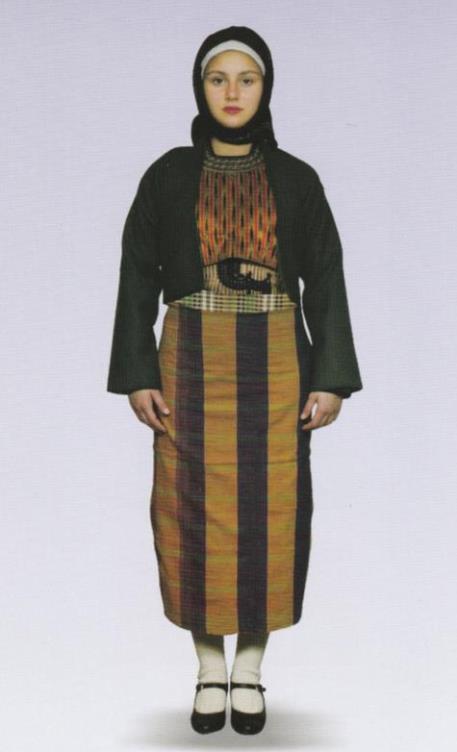
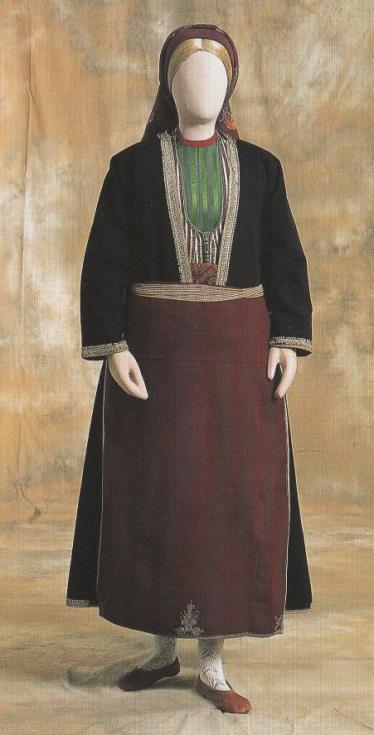
- Coats/jackets: Short coats were usually worn in the warmer months and long coats in winter. The most important coats were:
- Kontes: A type of waist
jacket which was open in the front. It
was worn over the zipouna and was
made of felt or velvet—in the latter case it was called katifen. Well-off young
girls as well as newlyweds would wear the gold katifen, which was decorated on its edges and the sleeves with gold
embroidery (Plates 4, costume on the right & 5).
- Kontoghoun: A felt or velvet waist jacket which was lined around the collar to the waist with wolf or fox fur. The more expensive were decorated with gold embroidery on the edge of the waist and at the sleeves (Plate 4, costume on the left).
- Makroghoun: A fur-lined long overcoat which went down to the ankles. It was open in front and was made from local black or dark brown woollen fabric (Plate 4, middle costume).
- Libade: A long winter coat open in front and worn on top of the zipouna. It was made of flannel or cashmere. It was layered with cotton (Plate 8).
- Socks: There were two types of socks, the ortarea—woollen socks worn in winter and the kaltzas—knitted from cotton in various colours and usually worn in summer. The ortarea were usually white with multi-coloured designs at the toes and the heels.

Plate 8: Libade overcoat (Amarantidis 2016).
2.4 Footwear
The most common footwear worn inside the house were embroidered slippers and the mestia—very light shoes made from thin red or yellow dyed leather. Outside, the women wore the nalia, a type of wooden clog. Women with the financial means wore kunduras, black laced shoes with low heels or the potine which were low boots and the lustrine. Villagers usually wore pig skin moccasins. (Nalia were worn with or without shoes for protection against mud and water. They were also worn by people in Anatolia who visited Turkish baths to protect their feet from the wet floor (Diamantidou 2014).)
2.5 Head coverings
- Tapla: This was a low disk-shaped covering [around 10 cm in diameter] which had a row of coins sown onto its front. The top of the tapla was covered with black or deep blue silk braids. It was usually worn tilted toward the forehead and was supported by two silk strings which were tied at the back of the neck. The tapla was worn by both girls of marriageable age (15–16 years old) and married women. Elderly women also wore the tapla but with the gold coins removed. The tapla was not worn in Santa or in the larger Matzouka area (south of Trabzon).
- Tepelik: The tepelik was a type of tapla whose top had a decorated thin silver or gold plated circular piece of metal or foil sewn onto it, decorated with embossed linear or floral designs (Plates 4–5 & 9–10). The top of the tepelik could also be covered in overlapping gold or silver coins (Plate 10 bottom). A third variation had filigree decorating the metal disk of the tepelik.
- Koursin: This was a type of tepelik, whose top was decorated with embossed gold threaded embroidery or gold tinsel. Often it had, as an extension, a gold thread tassel which was placed hanging down over the left temple. The tepelik or koursin were usually worn by young women of comfortable means.
- Head scarves worn by girls over 15 years of age and young women: These women wore the tapla which for [regular] wear was covered with a special scarf called letzek. These rectangular scarves were made of thin material in a variety of colours and folded into a triangle and placed on top of the head. The two free ends could be crossed over at the back of the neck and tied on the top of the head. On festive occasions, these females wore the tapla or tepelik without any head scarf.
- Head scarves worn by middle aged and elderly women: These scarves were dark coloured. They were tied for everyday wear the same as above but for festive occasions they usually wore the scarves untied so as to cover the head with the forehead exposed and the two ends falling freely in front of the shoulders.

Plate 9: Silver gerdanluk around the neck with the zipouna and tepelik (Amarantidis 2016)
2.6 Jewellery and ornaments
Besides the tepelik with its gold coins and the gold embroidered koursin, Pontic Greek women wore many forms of jewellery which included the following:
- Ora (pocket watch): This pocket-watch with a gold or silver kiostek (chain) hung from the neck, with the watch [often] sitting in a pocket.
- Earrings: A large variety of earrings were worn made of gold, silver, valuable gems, pearls or coins.
- Rings: A variety of rings including many inlaid with precious stones or pearls.
- Cross, metallion and karditsa: A gold or silver cross and chain worn hanging from the neck over the chest. A gold round ornament (metallion), or heart-shaped ornament (karditsa) could also be hung over the chest from the neck by either a silk cord or gold chain.
- Bracelets: The most valuable bracelets were made of gold or silver, either in the form of a clasp or gold or silver wired mesh with a width of 3–4 cm. [There are photographs of these bracelets being much wider than 4 cm (Plate 11).]

Plate 10: Two types of tepeliks (Amarantidis 2016).
- Kustin: This was an ornament made from coins sewn together in a line on a band of fabric. They were either of a semi-circular shape placed around the neck or the shape of a triangle with two corners toward the neck and the third toward the belly button where it terminated with either a cross, a coin or a medallion.
- Gerdanluk: This was a composite necklace made from chains, coins, beads and silver or gold pieces in various shapes sewn on a narrow felt band and tied at the back of the neck (Plate 9).
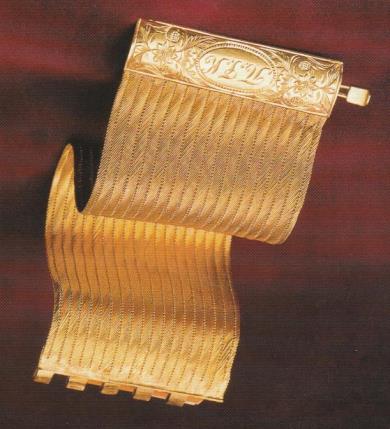
- Kohlidh: This was a long necklace made of gold or silver spheres which was wrapped around the neck once or several times (Plates 1 & 5).
- Tsangale: This was a type of silver buckle which was attached to a leather or gold embroidered belt worn at the waist.
2.7 Specific regional costumes
a. Santa: The seven villages of Santa, south of Trabzon, are between 1,500 m and 1,800 m in elevation. [It was a cold area so people needed warm clothes.] Santa is also about 27 km east of Hamsikoy (in Matzouka). It was an entirely Greek area, almost cut off from the outside world by the mountains on three sides and easily defended to the north by ravines. Their people were famed for their independence and fighting spirit (Bryer 1968, pp. 108–9).
The women’s dress of Santa differed from other costumes of Pontos. They wore a felt overcoat and did not wear the tapla or tepelik—being replaced by a head scarf (Plate 7).
The underpants were a little longer than normal, going from the waist to the knees. The sparel (covering the chest) was also much larger than those of the Matzouka region.
The zipouna however, had smaller side openings at the bottom of the dress [to retain body heat]. They were made of striped silk commonly in a variety of colours. Brides from Santa often wore two or three zipounas, one on top of the other which differed by a few centimetres in length so that they appeared in tiers on the hemline.
The most significant overcoat of Santa was called tsoha. The tsoha was unlined, open in front and fell to the ankles. It was made from deep blue English felt and was decorated with gold embroidery at the collar, the sleeves and hem. It was also used as a wedding dress (Plate 7).
The apron of Santa was rectangular and made of local deep crimson fabric (Plate 7). The bridal and festive apron, also called tsoha, was made of quality English felt, the same quality as the outer coat but of a deep red colour. The perimeter was decorated with silk cord or gold thread. The apron was worn on top of the outercoat (Plate 7). Another type of apron worn was the fota, with its wide stripes in two alternating colours. It was worn on top of the zipouna and the waistband and was tied at the waist.
Finally, the head was covered with the letzek, a special square scarf of fine fabric with various colours depending on the age of the woman.
b. Matzouka: Around 1920, there were 70 villages in Matzouka (south of Trabzon) with nearly 22,000 people, 76% of whom were Christian. Walnut groves surrounded the area until 1920 after which the area was called Machka (Bryer and Winfield 1985). [Emeritus Professor Anthony Bryer (personal communication, 2007) advised me that the modern Turkish placename, Machka, was derived from the Greek area it commanded, Matzouka (meaning club). The place itself was called Dikaisimon in medieval Greek and named ‘Cevizlik’ (i.e. walnuts) by the Ottomans.]
Generally, the women’s dress was similar but were shorter and tighter in comparison to the rest of Pontos (Plate 6). The underpants were narrower and shorter and the shalvar was also shorter, only reaching the knees.
The zipouna was mostly made of variously coloured striped silk. More rarely, they were one colour as well as those of the silk koutni [silk and cotton-like material] of ikat type [a dyeing technique used to pattern textiles]. It was also much shorter reaching only to mid-calf in length. It had low slits [on the side] and buttons at the mid-section not at the middle, but at the side.
The bridal and festive sparel were made exclusively of koutni fabric of the ikat style. It was always worn on top [not underneath] of the zipouna, covering the chest (Plate 6). The formal waistband, the tarapouloz zonar, was rectangular in shape about 3 m long and made of multi-coloured silk. It was similar to the men’s waistband.
The basic overcoats for women in Matzouka were the saltamarka (short coat) and the tsoha. The saltamarka was made of European black felt lined with cotton fabric. The tsoha was similar to the saltamarka but it was a simpler short woollen coat in a greenish-khaki colour, without lining or decoration (Plate 6). [The name tsoha was used for many different garments.]
The two main types of aprons in Matzouka were the fota and the koknetsa. The fota always had white as one of its two alternating striped colours. It was worn on top of the zipouna and the waistband.
The koknetsa was a locally-made rectangular woollen cloth often of a deep red colour.
The women of the Matzouka region did not wear the tapla. They braided their hair which was covered with a white head scarf. They placed the letzek on top of this scarf. The letzek was a triangularly folded black head scarf. Next, the two free ends crossed under the chin and were tied behind the head (Plate 6). Special bridal jewellery on the chest was the perpentoulia, which was comprised of silver chains, coins and metallic fragments.
Hortokop is near the settlement of Machka, 25 km south of Trabzon. In this village, the bride’s wedding clothes included white woollen socks, a blouse, koutni sparel, the zipouna dress, a blue apron [and a short open coat] and two head scarves, one worn on top of the other. On her forehead, the bride wore perpentoulia made up of beads and imitation gold currency hung from a red ribbon and tied to the back of the neck. She also wore a white veil (A Papadopoulos (1954) in S Papadopoulos (1983)).
- Samsun, Kars and Tsalka: Dresses in the areas around Samsun vary slightly from the general dress codes of Pontos. The dress differed in two ways. The first was the prevalence of the kontoghoun jacket instead of the gold katifen jacket. The second was the shape of the zipouna. The two front panels of the dress appear to have been significantly narrower than those of the classic zipouna and also shorter than the respective back panel. As a result, the lower front part of the shalvar was visible (Plate 12).
There is little information about the dress of the Bafra area (near Samsun). [Clothier, Peter Kouvelis, (personal communication, July 2019), believes zipounas from Bafra had scallop edges.] Finally, Pontic Greeks who moved and settled in the area of Kars and Tsalka [in the Caucasus] gradually abandoned the dress habits of their original villages/centres from Pontos, adopting European elements of dress. [They also adopted some Russian clothes.] Until the beginning of the 20th century, they preserved some of the old garments in use which had a symbolic character, e.g. the tapla or the sparel.
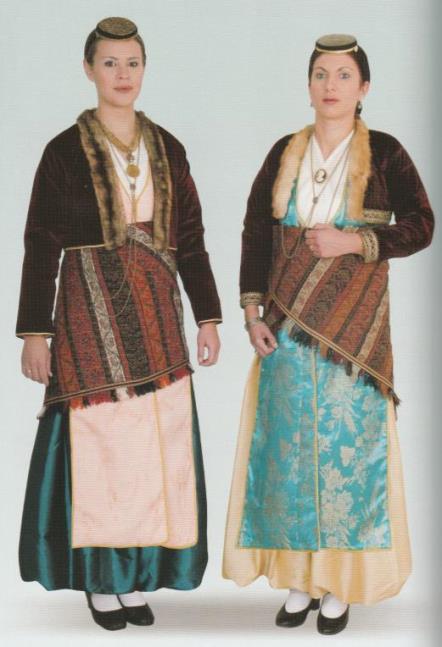
- Traditional Pontic Greek Male Costumes
3.1 Introduction
The information here on the traditional Pontic Greek men’s clothing is incomplete. From the second half of the 20th century, men began to adopt trousers such as the shalvar, the potour (Plates 13–14) and then the zipka (Plate 15). From the end of the 19th century to the beginning of the 20th century, there was a variety of cultural dress among men in Pontos. This ranged from western suits to traditional Pontic clothes. (The zipka was a Caucasian costume that was adopted by Pontic Greek men, but also Armenians, Laz and Turks. It appeared in Pontos just before 1900 (Diamantidou 2012b).)
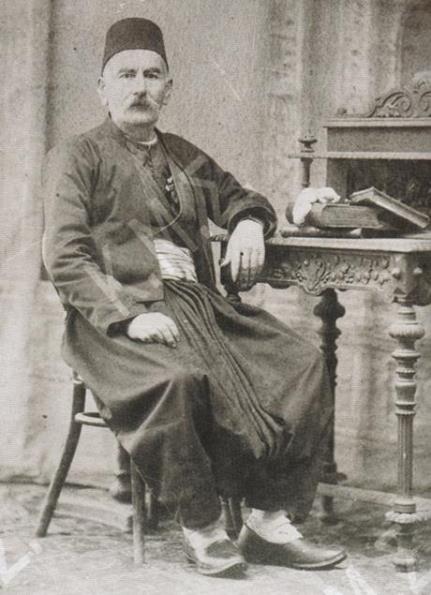
From the end of the 19th century, most men living in major urban centres had adopted the western suit. However, there were still many clothiers who continued to make traditional Pontic clothing. These clothes were determined by the age of the wearer and his financial means. [It was also influenced by the climate.] Studying the basic popular clothing among Pontic Greek men around 1910, Amarantidis (2017) makes the following observations.
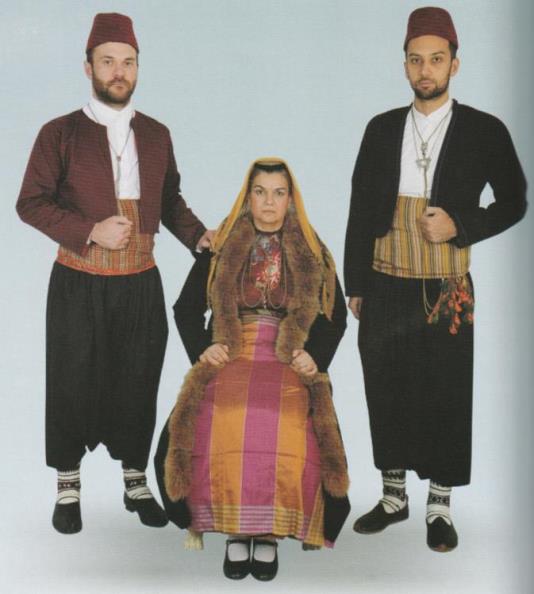
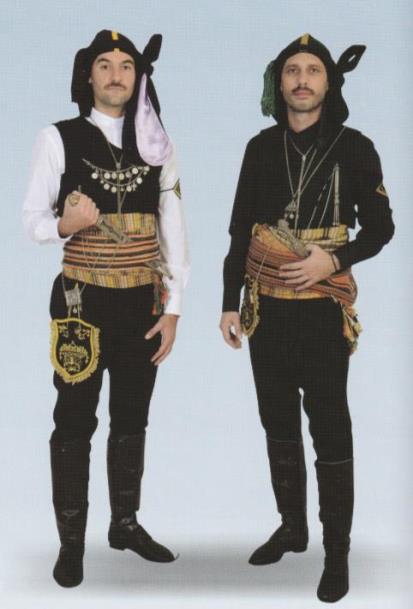
3.2 The costume with the shalvar and potour
Under garments
- Kamis (shirt): The kamis was made of white cotton fabric with a narrow collar and long sleeves. The chest had a vertical opening to just above the navel with three buttons. The kamis could reach the thighs. They were made of silk or linen-silk for the younger, newlyweds and the well-off.
- Sovrakon (underpants): The underpants went from the waist [and could reach the ankles]. Under the knees it narrowed and ended in two ribbons which were tied around the legs.
Vests
- Ghelek: A short vest to the waist which was worn over the shirt. It was made of white cotton, linen, felt and striped silk koutni or silk. It could be crossed in front, with several buttons.
- Tzamntan: A crossed vest worn over the shirt. Made from black felt or domestic black woollen cloth, it included two rows of buttons from the shoulders, descending to the navel, converging toward the midline (Plate 16).

Plate 16: Pontic Greek men from near Giresun (on Black Sea) in local costume (1910–12) (Amarantidis 2017).
Jackets
- Zupuna: This jacket for everyday wear was made from cotton or cheap woollen fabrics, while more formal versions were made of silk. There were two types of male zupunas, the cross-over and the open. The cross-over zupunas were worn over the shirt and were fastened with a button near the shoulder, or on a shoulder and a lower side. The open zupunas left the chest open to the navel, then buckled to become a waistcoat.
- Kapaklin: A crossed, short halfway garment worn over the shirt. It was made from cotton or linen and was embroidered.
- Ishlouk: A short garment worn over the shirt without a vest, replacing zupunas. It was made of cotton, linen or silk. It also could be crossed and buttoned at the neck (Plate 16), or open in the middle and buckled to more buttons arranged along the vertical opening.
Trousers
- Shalvar–karavona: These were trousers giving its name to the whole costume which was known as ta shalvar. They were wide around the waist and the knees and made from domestic woollen fabric or European felt for middle-aged and elderly men (Plate 13) while cotton cloth (black or dark blue) was reserved for younger men and called karavona (Plate 14 & 17).
- Potour: The potour differed from the shalvar or karavona in that while the top was wide, below the knees the potour narrowed like a zipka (see section 3.3). It was made from domestic wool or European felt (Plate 16). Diamantidou (2012b) states the potour was a daily garment in dark colours which had 10 cm slots on either side of the ankles to allow the foot to pass through.
Zonars (waistbands)
The waistbands worn by non-wealthy older men were made of domestic white wool, while those worn by non-wealthy younger men were made of black wool or dark blue cotton. The zonar was around 3–4 m long and 40 cm wide. Pontic Greeks on festive occasions wore the following type of zonars:
- Edjemshalin: This was the most expensive zonarand was made from Persian wool with colourful wide stripes. [This was the same name as the zonar worn by women.]
- Tarapouloz: This zonar was rectangular and made of thin silk brought from Tripoli in Libya. It was colourful with dense vertical and horizontal streaks forming small squares (Plates 14–15 & 18). (See section 3.3.) [Same name as the women’s waistband.]
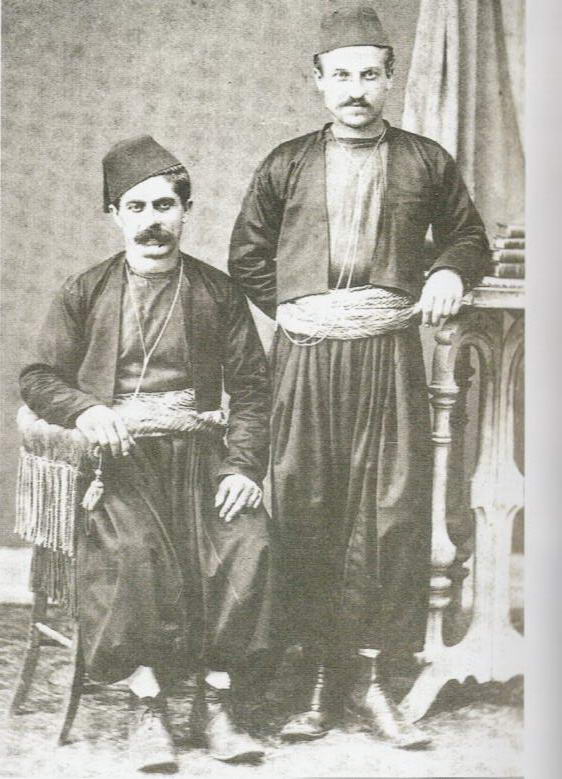
Coats
Short coats were usually worn in the warmer months and long coats were worn in winter. The most important coats included:
- Saltamarka, kotsik, kontes: They were similar short coats made of domestic black woollen cloth or felt. They were open in front [with no buttons]. They were decorated with a cord and had one or two external or internal pockets. They were worn over the zupuna, the ishlouk or the ghelek (Plates 13–14 & 17). (The coat also came in longer lengths, e.g. down to the knees and to the calves (Diamantidou 2012b).)
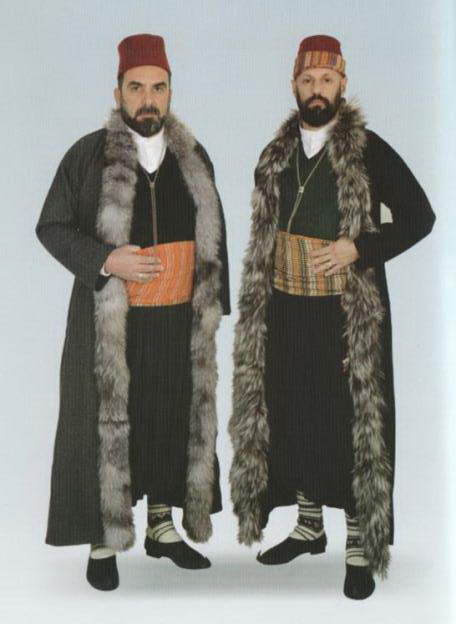
- Makroghoun: This was a long coat, which went almost to the ankles with a narrow collar. It was open in front and made of black, grey, brown or olive green felt. It was lined with fox, wolf or ferret fur. It was worn in winter by the elderly, the clergy and generally wealthy men (Plate 18).
- Tsoha, kaftan: This was similar to the makroghoun but had no lining.
- Maslagh: This overcoat was in the shape of a shepherd’s cape and was made of light brown wool. It was open in front and reached below the knee.
Covers for the limbs
- Gloves: These handmade woollen gloves were white or coloured.
- Leggings: Hand-woven white woollen leggings commonly were worn by the elderly during winter. They were not usually worn with the long shalvar, zipka or potour.
- Ortarea (socks): Hand-knitted socks made of white or black wool. They could be short or long up to the knee (Plates 14 & 18).
Fez hat
With a costume with trousers, the head was covered with a moulded fez made of felt. The fez was usually crimson in colour and rarely black. Around the base of the fez, the elderly tied a black scarf while younger adults tied a colourful piece of silk (Plates 13–14 & 16–18). (Note 1.) (At the top of the fez there was often a stitched tassel (Diamantidou 2012b).)
Footwear
The men wore a variety of footwear with the shalvar and potour costume. They included:
- Tsaroushia: This was the simplest shoe worn by farmers and generally non-wealthy men. The simplest tsaroushia were home-made of ox or pig skin, while the best quality were made from well treated ox or buffalo leather. The nose and behind the heel of the shoe were rounded.
- Mestia: This was a slightly low shoe of thin black leather. They were worn in the house and outside for special occasions.
- Yemenia: These shoes were low cut black leather and closed in front (Plates 13 & 16 man on the left). According to Diamantidou (2014), these shoes took their name from the country of Yemen and were made of very soft goatskin. Their soles were very thin or non-existent.
- Kountouras: A shoe with a heel made of European leather in black and covering the leg to the ankle. Sometimes the sole had metal nails. This shoe eventually replaced the yemenia. (They were worn by both men and women (Diamantidou 2014).)
- Kaloshia: An outdoor shoe made of hard leather. Men and women wore them over the mestia or kountouras when it rained and during visits to other people’s homes.
- Potinia: These were low, black leather boots with laces and a tongue (Plate 17).
- Loustrini: A low shoe of shiny black leather intended for affluent men.
3.3 The traditional zipka costume
According to Diamantidou (2012b) the zipka was a Caucasian costume that was adopted by Pontic Greek men, Armenians, Laz and Turks. It appeared in Pontos just before 1900. Amarantidis (2017) states the costume was widespread among the younger men across Pontos. The outer wear featuring ‘ta zipkas’ (Plate 15) consisted of the following:
- Zipka: A type of trousers, wide at the top and tight from the thighs to the ankles. Made from domestic or thin English woollen fabric, usually black or dark blue, rarely brown, olive green, dark green and light blue (Plate 15).
- Meshte: [Black leather coverings between the knees and ankles with laces on the outside of the shin (Plate 15).]
- Kontes, mindan: Coats worn over the shirt and the vest. They could have a slightly overlapping front. [Vests worn here seem no different to other male costumes.]
- Tarapouloz zonar: This waistband was similar to the one described in the costume with the shalvar–karavona and potour trousers. On each end were fringes that resulted in colourful silk [small tassels]. A leather belt was worn on top of this zona (Plate 15).
- Pashlouk: This was a peculiar shape of headgear made of the same fabric as the zipka. It had a hood with two arms around 1 m each. The surface covered the forehead to the top of the head and was decorated with gold band or braid and ended with a string with a tassel. The arms of the hood were also trimmed with braids around the edges, which were lined with satin in various colours such as dark or light blue (Plate 15). (The pashlouk was up to 2 m long, with arms on the left and right of 30 cm width which were tied around the head (Diamantidou 2012b).) [See <www.youtube.com/watch?v=Ap-U-4K3Q2U&t=150s> where Nikos Zournatzidis, the famous Pontic Greek dance teacher, demonstrates the different methods of tying the pashlouk.]
- Selahi (leather belt): The Pontic Greek men wearing ‘ta zipkas’ put on top of the tarapouloz waistband the selahi, a leather belt with a wide front. On the selahi they placed their weapons like a pistol and the kama (knife). [On modern made selahi belts, there is also a tobacco pouch hanging below the belt (Plate 15).]
- Tsapoulas footwear: Besides the shoes described previously, Pontic Greek men who wore zipka also wore tsapoulas. These shoes were low cut made of black leather with a closed front. According to Diamantidou (2014), the leather used to make tsapoulas was tough with 0.5 cm leather soles with a heel of 1.5 cm made of hard leather or wood.
- Russian boots: [Some photographs from the early 20th century in Pontos show Greeks wearing leather boots with their zipkas.] Diamantidou (2014) states these boots were adopted by Pontic Greeks after they were worn by the Russian army soldiers who captured Trabzon in 1916 [they left Anatolia in early 1918]. The boots reached the knee and were made of soft leather with a hard-leather sole. They were black, grey or dark brown.
Jewellery
The most common jewellery for both types of costumes, i.e. shalvar–karavona/potour and zipkas were the following:
- Ora (pocket watch): A silver chain worn from the neck and ended with a round pocket watch that was held in the waist-coat pocket.
- Kiostek: Silver jewellery consisting of pieces and chains worn across the chest (Plate 15, costume on the left).
- Filahto (good luck charm): Triangular shaped silver jewellery hung on the chest with a silver chain hung from the neck (Plate 15).
- Egkolpion: A square or rectangular silver ornament hung from a chain from the neck. On one side it depicted St George slaying the dragon and was worn diagonally across the body [sitting just past the waist] (Diamantidou 2012b) (Plate 15).
- Conclusion
Traditional Pontic Greek costumes are now spectacularly displayed in Greece and in the Pontic Greek diaspora during Pontic Greek cultural association dances and other Pontic cultural events. It is wonderful that these costumes are still being proudly worn today.
It should not be forgotten that before the Population Exchange in 1922–23 of Christians from Ottoman territories to Greece, the people of Pontos had a shared culture. This included many similarities between the traditional costumes of Pontic Greeks and Pontic Turks. But this is another story that will need to be addressed in detail in the future.
- Notes
Note 1
In 1829 the Ottoman sultan specified the clothing and headgear to be worn by civil and religious officials. It was an attempt to eliminate clothing distinctions that had long separated the official from the subject classes and the various Ottoman religious communities from one another. He ordered that his bureaucrats were to wear a plain fez (Plate 13), expecting that most people would also adopt the new headgear. It seems, the more prosperous non-Muslim men in larger urban centres wore the fez to escape discrimination. Non-Muslims expressed their wealth through their clothing. Thus, non-Muslim merchants aspired to appear like Muslims (Quataert 1997).
Note 2
From 1838, Trabzon’s trade was stimulated by trade agreements with Europe and Russia. The Crimean War (1853–56) also had a positive impact on Trabzon’s trade (Braude and Lewis 1982). By 1867 the British consul in the port of Trabzon reported that the Pontic Greeks ‘do not aim at equality, which they have already got, but at mastery’ [i.e. they were becoming prosperous businessmen] (Bryer 1970, p. 51).
By 1884, the foreign trade in Trabzon was dominated by Greek and Armenian merchants. European diplomats and consuls in major Ottoman urban centres, for their own aims, extended the rights given to their own nationals to some non-Muslim Ottoman subjects. In this way, they created a privileged class—by helping them obtain tax exemptions and preferential treatment (Braude and Lewis 1982).
In addition, Bryer (1970) states Samsun’s commercial revival began with the building of the highway south to Amasya and with the extension of the tobacco industry of nearby Bafra. By the 1860’s Samsun became the port of the main Constantinople-Bagdad route and was finding international markets for its tobacco. In Samsun, Greeks dominated its commercial life. Of the 214 businesses in Samsun in 1896, no fewer than 73% were owned by Greeks. In 1913 much of the trade and wealth of the town was still in the hands of the Ottoman Greeks.
Note 3
In 1904, Singer sewing machines opened its first dealership in Turkey. For many years Singer went to mountain villages in Anatolia and showed people how to use these sewing machines (<www.singer.com.tr/en/corporate/history> viewed July 2019).
- Acknowledgements
Thanks to Kyriakos Moisidis, the famous Greek dance teacher, for introducing me to the 2016 and 2017 ‘Kyklos’ calendars (diaries) with texts written on traditional Pontic Greek costumes by Ioannis Amarantidis. I also thank Michael Bennett, Peter Kouvelis and Russell McCaskie for their comments on a draft of this paper. For those interested, traditional Pontic Greek costumes can be purchased from the clothier (and musician) Peter Kouvelis from Sydney <pkouvelis@hotmail.com>.
- References
Amarantidis, I 2016, 2016 calendar: costumes of the Greek women of Pontos, (English translation by J Graziosi & Y Hunt), Centre for the Study of Traditional Dance ‘Kyklos’ Thessaloniki, Thessaloniki.
Amarantidis, I 2017, 2017 calendar: costumes of the Greek men and women of Pontos, (English translation by T Paraskevopoulos & Y Hunt), Centre for the Study of Traditional Dance ‘Kyklos’ Thessaloniki, Thessaloniki.
Andrianopoulou, P 2005, ‘Folk costumes in the Pontos’, (English translation by G Velentzas), Encyclopaedia of the Hellenic World: Asia Minor, at: <www.ehw.gr/asiaminor/forms/fLemmaBodyExtended.aspx?lemmaID=8993>.
Braude, B and Lewis, B 1982, Christians and Jews in the Ottoman empire: the functioning of a plural society: the central lands, vol. 1, Holmes & Meier, New York.
Broufas, C 2000, 40 Greek costumes from the Dora Stratou Theatre collection, Dora Stratou Theatre, Athens.
Bryer, A 1968, ‘Nineteenth-century monuments in the city and vilayet of Trebizond: architectural and historical notes Part 2’, Archeion Pontou, vol. 29, pp. 89–129.
Bryer, A 1970, ‘The Tourkokratia in the Pontos: some problems and preliminary conclusions’, Neo-Hellenika, vol. 1, pp. 30–54.
Bryer, A and Winfield, D 1985, The Byzantine monuments and topography of the Pontos, vol. I, Dumbarton Oaks Research Library & Collection, Harvard University, Washington D.C.
Diamantidou, M 2012a, ‘Women’s clothing’ in Pontosnews at: <www.pontos-news.gr/pontic-article/3354/gynaikeia-endymasia>.
Diamantidou, M 2012b, ‘Men’s clothing’ in Pontosnews at: <www.pontos-news.gr/pontic-article/3355/andriki-endymasia>.
Diamantidou, M 2014, ‘The costume in Pontos’ in Pontosnews at: <www.pontos-news.gr/pontic-article/105065/i-endymasia-ston-ponto>.
Faroqhi, S 2016, A cultural history of the Ottomans: the imperial elite and its artefacts, IB Taurus, London.
Kaldellis, A 2019, ‘Ethnicity and clothing in Byzantium’, in K Durak & I Jevtić (eds) 2019, Identity and the Other in Byzantium: papers from the Fourth International Sevgi Gönϋl Byzantine Studies Symposium, 23–25 June 2016, Istanbul: Koç University Stavros Niarchos Foundation Centre for Antique and Byzantine Studies, pp. 41–52.
Papadopoulos, S 1983, Events and cultural characteristics regarding the Pontian-Greeks and their descendants, PhD thesis, School of Education, Health, Nursing and Arts Professions, New York University, New York.
Quataert, D 1997, ‘Clothing laws, state, and society in the Ottoman empire, 1720–1829’, International Journal of Middle East Studies, vol. 29 (3), pp. 403–25.

